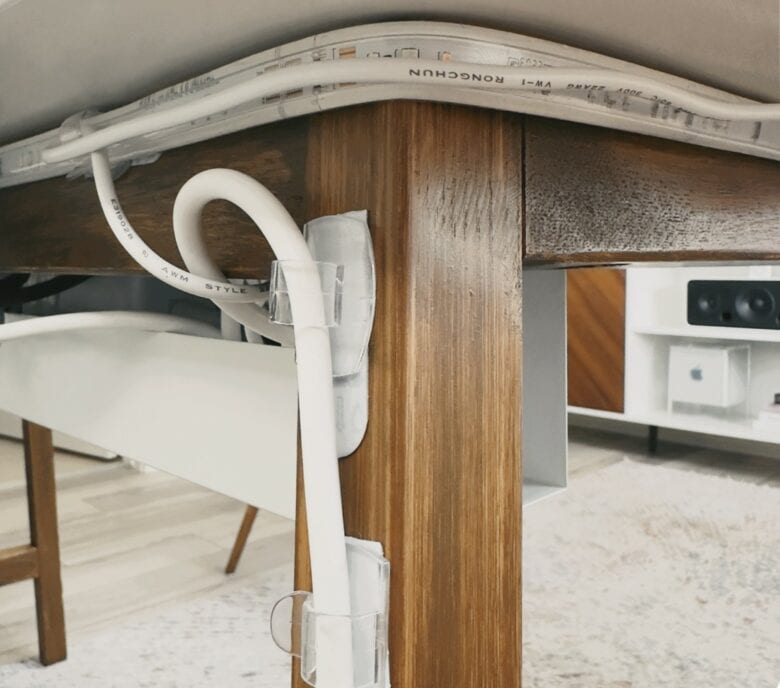Today’s featured computer setup comes from Mac maven and designer Basic Apple Guy. We know him from the free wallpapers he offers for download. Who knew he was such a cable-management Jedi?
We came across his powerful setup with nary an unsightly cable while writing about his new “Flow” wallpaper — which was actually inspired by his fight with cable clutter.
This post contains affiliate links. Cult of Mac may earn a commission when you use our links to buy items.
Basic Apple Guy’s web post is a cable-management clinic
In addition to putting out the “Flow” wallpaper it led to, Basic Apple Guy wrote about his setup and its cable management in a post entitled, “FIND A SINGLE CABLE. I DARE YOU.” Click through to read all the details in his well-written tale.
He described his distaste for visible cabling as essentially inherited from his family. He talked about the tedious tucking of every single Christmas tree light behind and under branches while growing up, for example.
“There must be a genetic component because I’ve always been a little obsessive about ensuring cables remain as discrete as possible,” he wrote. “Thankfully my condition developed to be a little milder.”
Mild or not, it’s perfect for teaching others how to deal with annoying wires they don’t want to see.
Mac Studio setup

Photo: Basic Apple Guy
So naturally he wanted to keep his Mac Studio setup as clean-looking as possible. He said his previous iMac setup was easier to deal with, given that machine’s single cable.
And he had practical reasons for decluttering cables as much as possible, no just genetic ones.
“The space where this desk resides is under 100 square feet but also houses our tech storage, bookshelf, couch/pullout bed and a growing collection of plants. Keeping the area minimal aids in keeping the space feeling as large as possible,” he noted.
He made it a bigger challenge by having no backing behind his desk to hide cables, as you can see in the images.
He’d have just the thickness of the desk top to hide eight annoying cables, including those for main hardware power supplies, Thunderbolt 4, HomePod minis, SSD, surge protector and Philips Hue Lightstrip.
Favorite invention ever: A light clip

Photo: Basic Apple Guy
He got off to a good start with his favorite all-time invention, a simple clip:
Before the SSD and Lightstrip, I managed to tuck and snake all of these cables down the table’s left back leg and have them connect to a surge protector hidden behind the horizontal beam at the bottom. To guide the lines, I turned to my favourite of all inventions: 3M Command Outdoor light clips.
These translucent clips securely affix to furniture and provide the structure that allows me to guide most of my cables down. When I first got the Mac Studio, the cables increased such that I couldn’t secure all of them with a single clip (collectively, they were too thick). I added a parallel channel alongside my original to guide the new cables down the same leg.
Addition of light strip ruins everything
But then he had to re-do it all when it came time to add a Philips Hue light strip:
The extra hardware and cabling finally required me to rejig my entire setup; I couldn’t hide the pieces behind the beam of the desk and needed to opt for a cable tray to conceal the growing bundles of cables and plugs. Fortunately the overhang of the white desk helps to perfectly obscure the light strip running around the desk, making it invisible from every angle.
And so does the wrong choice of cable tray

Photo: Basic Apple Guy
Likewise, his first attempt to use a plastic cable tray didn’t work out because it was too short and too flimsy.
“So I upgraded to a taller metal C-shaped tray that allows cables to enter from the sides and back but hides everything when viewed head-on,” he said.
Then, after redoing his clips to guide cables into the tougher, deeper tray, he was done.
“Now [I] have a setup that, from nearly any angle inside the office, conceals all the wiring,” he said. “Integrating technology into small spaces while making the areas feel beautiful and organic is not always easy.”
Shop these items now:
Computer:
Display:
Input devices:
- Magic Keyboard (mini)
- Magic Mouse 2
Audio:
Furniture and accessories:
Cable management:
If you would like to see your setup featured on Cult of Mac, send some high-res pictures to [email protected]. Please provide a detailed list of your equipment. Tell us what you like or dislike about your setup, and fill us in on any special touches, challenges and plans for new additions.
You can use the trays to as power strip holders, cord organizers, wire tamers for office and home. In black, 2-pack (DESK-AC06-2C).
![Learn to tame cable clutter with Basic Apple Guy [Setups] See any cables here? We didn't think so.](https://www.cultofmac.com/wp-content/uploads/2023/08/Basic-Apple-Guy-setup-1-.jpg)


